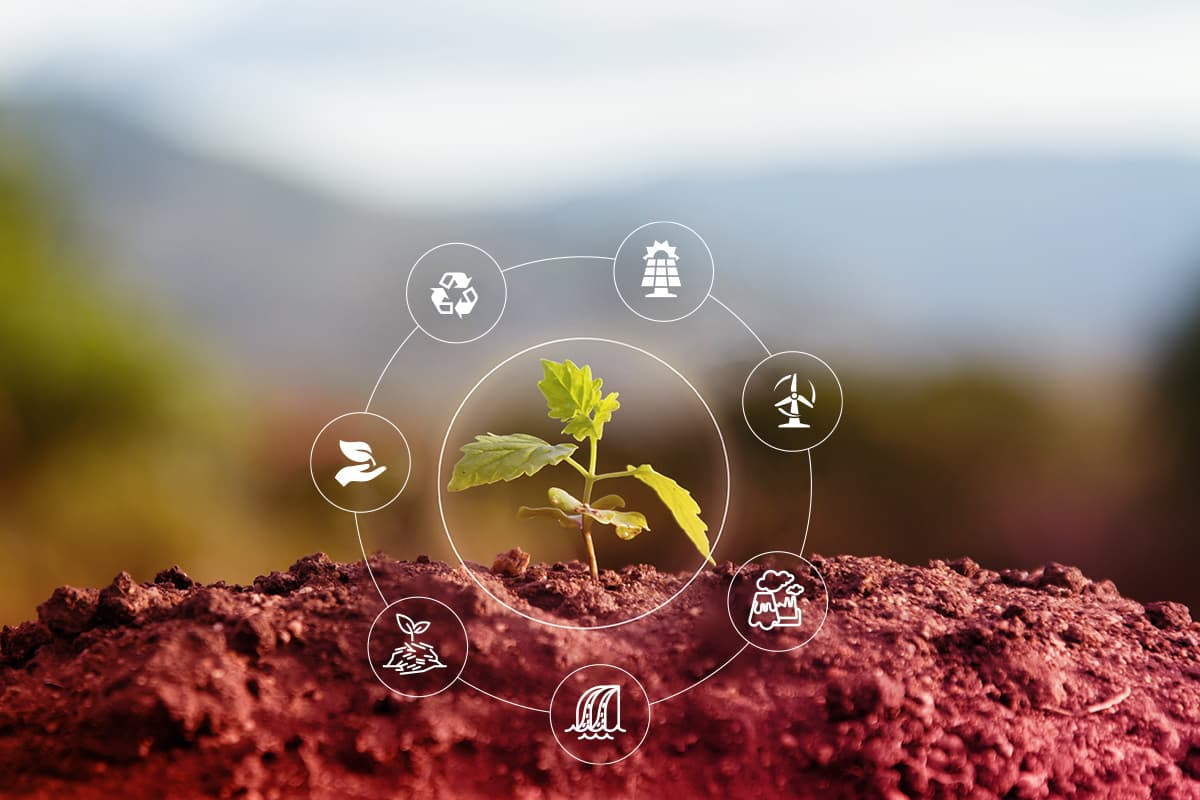
What is Climate Change? Impacts of Climate Change and Precautions to be Taken
What is in this article?
The advancements in production technologies and transportation infrastructure, particularly post the Industrial Revolution, have been instrumental in driving global growth. The swift progression of railways and highways, coupled with shifts in leisure activities and consumption patterns, have profoundly transformed the way people live. On the surface, this evolution might appear as a stride forward. However, it has also led to the accelerated depletion of limited resources like energy and water across the globe, not to mention the surge in carbon emissions due to such consumption.
At its core, climate change is an altered equilibrium brought about by both man-made and natural factors. Yet, in contemporary discourse, human actions are frequently pinpointed as the primary culprits behind these shifts.
Delve deeper into the blog to explore facets of climate change – its origins, consequences, and potential mitigation strategies.
What is Climate Change?
Climate change is characterized by enduring shifts in temperature and precipitation patterns, primarily attributed to the rise in the concentration of greenhouse gases in the Earth's atmosphere.
Both anthropogenic activities and natural phenomena can be sources of these climatic alterations.
Predominantly, the atmosphere's greenhouse gases include carbon dioxide (CO2) and water vapor (H2O). Other significant contributors are methane (CH4), ozone (O3), nitrous oxide (N2O), hydrofluorocarbons, and chlorofluorocarbons. An increased concentration of these gases in the atmosphere is a key driver of climate change.
The natural and artificial causes of climate change can be listed as follows:
Natural Causes
- Aerosols from volcanic eruptions
- The effect of the rising temperature due to the magnetic fields created by sunspots
- The temperature-raising effect of solar flares due to the radiation they emit
- Carbon sequestration in permafrost (polar and tundra regions)
- Forest fires of natural origin
- Water vapor
- Impact of animal feces and consumption on methane and carbon dioxide emissions
Artificial Causes
- Sulfur dioxide-derived sulfate aerosols from the combustion of fossil fuels (coal, oil and natural gas) and organic materials
- Deforestation and human-caused forest fires
- Growing landfills due to lack of garbage segregation
- Increasing carbon footprint rates as a result of overpopulation
- Gases emitted by mining and changes in landforms
- Consumption habits
The most striking situation related to climate change in recent years has been the widening gap between seasonal temperature differences. Furthermore, these temperature fluctuations have started instigating climate-induced migrations. Predictions indicate that the rate of such migrations will surge substantially in the near future.
A particularly poignant event linked to climate change transpired in 2022. Due to an unprecedented temperature spike in August, over 1.700 individuals tragically perished within a mere span of 10 days.

What Does Global Climate Change Lead to?
- Global climate change sets the stage for a number of changes in the seasonal balance of the world and earth events.

- Temperature increase and extraordinary precipitation are among the most prominent consequences of climate change.
- In addition, climate change causes:
- Rising sea levels
- Changes in the structure of frozen continental fragments
- Changes in the structure of mountainous regions
- Disruption of the natural ecosystem
- Irreversible disruptions in the food production system
- Weather events escalating to the level of natural disasters.
Even just a 1.0ºC change in global average temperatures can lead to extreme heat, water scarcity and irreversible negative consequences for ecosystems.
The consequences of the already observed temperature change of 1.0ºC would force the world to deal with these problems today.
Predictions on global climate change suggest that the pace of temperature shifts will intensify in the upcoming decades.
Impacts of Climate Change on Energy
Climate change is intrinsically tied to global energy consumption. The greenhouse effect, caused by gases emitted from the burning of fossil fuels, has disturbed natural systems, leading to climate change.
A notable outcome of climate change is global warming. In this era, as temperature hikes become increasingly pronounced, it's been recognized that managing and curbing energy consumption is essential to counteract climate change.
Aligned with this, the United Nations climate commissions have set forth a directive that global energy consumption should be slashed by 35% to meet the goals set for 2030.
Impacts of Climate Change on Turkey
Turkey, due to its geopolitical position, ranks among the nations currently most impacted by climate change.
Owing to its industrialized economy and prevalent unsustainable consumption practices, Turkey ranked 18th among countries in 2021 with 4.75 metric tons of carbon emissions recorded in 2019.
Turkey is surrounded by seas on three sides and characterized by a continental climate inland, and it is vulnerable to the pressing impacts of climate change.
We can list these impacts as follows:
- Sea levels rising,
- Food production grinding to a halt due to heat and rainfall,
- Flooding, especially in coastal areas, and deaths due to temperature increase in summer,
- Loss of life, property and agricultural land as a result of increased floods and landslides in the Black Sea region,
- Irreversible deterioration of economic stability due to disruptions in production and distribution systems,
- Water scarcity and drought.
Individual Measures Against Climate Change
Although climate change is not caused solely by natural or man-made causes, it is possible to individually help prevent this global threat:
- Reducing fossil fuel consumption
- Use of renewable energy sources
- Reducing the carbon footprint
10 Most Effective Ways to Reduce Your Carbon Footprint
- Walking and biking instead of driving
- Reducing air travel
- Driving a hybrid vehicle and traveling with more than one person
- Saving money by paying attention to energy use at home
- Changing eating habits (to help conserve water and farmland, you can consume less meat, less processed fats, sugar and alcohol, and foods that are high in waste and energy consumption).
- Consuming locally made products
- Making recycling a habit
- Dedicating yourself to environmental protection and cleanliness
- Commitment to protecting and increasing green spaces
- Developing conscious habits around using electronic devices
Just some of the ways that should be followed to control carbon footprint are listed above. In response to these challenges, promoting conscious consumption, fostering environmental awareness, and cultivating collective sensitivity are crucial measures that need to be sustained.
Related Article

What is Recycling? Importance of Recycling
Measures Countries Can Take to Address Climate Change
Bureaucratic regulations at the state level have as much of a role in preventing climate change as individual actions. Countries play an important role in combating global climate change at the state level.
 We can list these methods as follows:
We can list these methods as follows:
- Control of fossil fuel use
- Use of renewable energy sources
- Protection of agricultural and forest lands
- Promotion of domestic production and consumption
- Review and control of industrial practices in the context of climate change
- Protection of water resources
- Developing strategies to ensure climate justice
- Developing management and organization strategies in the context of Sustainable Development Goals
- Establishing cross-country partnerships to combat climate change at the global level.
- Global climate change is one of the most important items on the global agenda threatening life on earth.
Mass migrations and irreversible deterioration of economic structures are enough to make countries politically and socially vulnerable. Consequently, the responsibility of ensuring life's sustainability should not only rest on individual endeavors but also be bolstered by collaborative strategies developed by nations.
Given that human behavior is a primary driver of climate change, there's a pressing need to elevate awareness on this front and implement measures to safeguard life.
The future problems of energy and natural resources due to climate change
It is predicted that climate change will accelerate unless individual and massive actions are taken. The anticipated shifts in temperature and precipitation pose a significant challenge to the continued sustainability of life.
A temperature shift of 1.0ºC is projected to intensify phenomena like heatwaves, devastating wildfires, floods, and extreme weather events, unless steps are taken to mitigate climate change.
The predicted consequences of an increase in the global temperature rate 2.0ºC degrees are as follows:
- Extreme heat: Temperatures observed in the Middle East and North Africa reaching the 50.0ºC mark, severe wildfires, and an increase in heat-related mortality rates
- Water scarcity and flooding: 8 percent of the world's population will be affected by water scarcity
- Ecosystem disruptions: 25% of 80,000 animal and plant species will disappear and the resulting behavioral changes will further trigger global climate change
Projected consequences if global temperature increases by 3.0ºC degrees:
- Permanent drought problems in northern Scandinavia, western Europe, and Mediterranean regions
- Fivefold increase of the heat waves which currently stand at three
- Disappearance of 43% of water resources in the Himalayas, which is a source of water for 800 million people
- Large-scale floods, droughts and severe forest fires posing a deadly threat to life
- Extinction of migratory animal species due to temperature rise on their migration routes
These trends, predicted for a future of about 100-200 years, pose a deadly threat to human life.
As glaciers melt, the emergence of previously dormant bacterial species could lead to new epidemics, highlighting one of the significant health concerns associated with climate change.
Climate Change and Figures
The issue of climate change began garnering global attention with the release of reports in 1990 by the Intergovernmental Panel on Climate Change (IPCC), established in 1988.
Affiliated with the United Nations, this panel is tasked with formulating strategies centered on implementing effective and long-term actions against climate change, a primary catalyst for global warming. The reports disseminated by this entity have highlighted alarming trends, revealing that the extent of global warming is intensifying steadily.
The Fourth Assessment Report, unveiled in 2007, contended that climate change is likely 90% due to human activities.
Conversely, the Fifth Assessment Report, released between September 2014 and 2015, adjusted this estimate to 95%, based on a more comprehensive examination of climate change scenarios. From these findings, it's evident that the mitigation of global climate change and its adverse effects requires combined efforts at both individual and collective levels.
The Sixth Assessment Report in this sequence, which is released roughly every five to seven years, was presented in August 2021.
Further notable insights from the global climate change report include:
- In comparison to the pre-Industrial Age, temperatures have risen by 1.0ºC, primarily due to post-Industrial Age manufacturing practices and evolving consumption patterns (such as increased use of coal and petroleum energy, heightened emissions from widespread transportation, and rising per capita carbon footprints).
- If greenhouse gas emissions persist at their current rates without alterations, it is projected that this increase will reach 1.5ºC.
- For Turkey, this scenario is already a reality, with an average temperature increase of around 1.5ºC. Regionally, temperature changes of up to 5.0ºC are conceivable.
- Furthermore, it has been observed that sea temperature fluctuations have doubled since 1980, and sea levels have experienced their most substantial rise in the last 3,000 years, beginning in 1900.

 Online Services
Online Services Application Inquiry
Application Inquiry Pay Assurance Fee
Pay Assurance Fee Query Installation Number
Query Installation Number Compensation Fee Inquiry
Compensation Fee Inquiry Automatic Payment Order Inquiry
Automatic Payment Order Inquiry Partnership
Partnership







Leave a Comment
Comments (1)
K
Kar prensesi
Ödevimde çok yardımcı oldu teşekkür ederim ama bir sorun var kaynakça olmaması Olsun birdakine bunu gözden geçirirseniz mutlu olurum Teşekkür ederim 😽🍫🧁🍭 İyi günler 🧁🍫🍭🍪